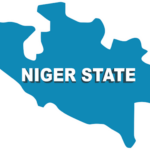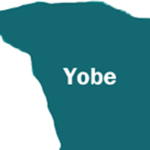Visitors from far and near last Saturday experienced spectacular display of colour, dance, culture and tradition that was showcased inside the Tafawa Balewa Square by various Eyo groups.
A large crowd of people made up of gaily dressed Lagosians from all walks of life thronged the venue to witness the Orisa play organized in honour of a former Chief of Iruland , Chief Yesufu Oniru who lived between 1864 and 1984.
Also not left out of the fun filled day were foreign tourists and children who turned out in very large numbers in the uniquely designed double-decker tourist buses.
Governor Babatunde Fashola of Lagos State, after the filing past of the various Eyo groups, affirmed that the Adamu Orisha play is a festival that the state government will continue to cherish and uphold from generation to generation.
The governor, who spoke after the well coordinated march of the various groups belonging to prominent families in Lagos and the five deities, said his administration is mindful of the economic effects of festivals and tourism destinations, adding that the Adamu Orisha has not been an exception in stimulating entrepreneurship and other economic opportunities for the people.
“The Eyo festival is one of the foremost festivals which identify us as a people; they are part of our beliefs and distinguishing emblems. Our culture is a summation of our beliefs and learned behaviours that must be jealously guarded and transmitted from the present to future generations”.
Governor Fashola said the Adamu Orisha play which is also known as Eyo Festival is a cultural experience that is unique to Lagos Island within a multi-cultural Nigeria where different cultures and traditions abound.
The governor said the late chief who was also the grandfather of the State Commissioner for Waterfront and Infrastructure Development, Mr. Adesegun Oniru won many legal battles against the acquisition of his ancestral property by the then emerging colonial authorities.
The Eyo festival featured a procession by several Eyo groups who were beautifully dressed in colourful hats, robes and wrapper with a staff. The groups danced and chanted various songs while greeting people by touching them with the tip of the staff they held.
Among the Eyo groups which featured in the procession were Jakande, Elegushi, Ajiweforisha, Oshodi, Etti, Salawe, Faji, Kakawa, Sogunro, Taiwo- Olowo, Bajulaiye Asogbon, Suenu, Bashua, Erelu Kuti, Egbe, Shaasi, Asajon, Eletu Odibo, Aromire, Obanikoro, Oshodi- Bukku, Onisiwo, Bajulu, Onitana, Oloto, Onilado, Akogun Olofin, Balogun okolo
Others are Apena, Oluwa, Alaagba, Saba, Aiyemosan, Olorogun Ide, Olorogun Adodo, Onimole, Olumegbon, Sasore, Onilegbale, Eletu Iwashe, Eletu Ijebu, Ologun Agbeje, Opeluwa, Akitoye, Sobaloju, Ashesi, Ogunmade, Olusi, Modile, Onisemo, Kosoko, Onikoyi, Awise, Ojon, Ojora, Onitolo, Olokun and Oniru.
The five traditional Eyo deity groups of Eyo Alagere, Eyo Ologede, Eyo Oniko, Eyo Alaketepupa and Eyo Adamu Orisha rounded off the displays.
Prominent people at the occasion were Prof. Wole Soyinka, the first Military Governor of Lagos State, Brigadier Mobolaji Johnson (rtd), members of the state executive council, members of the National Assembly, State House of Assembly, Oba of Lagos, Oba Rilwan Akiolu I, the Oniru of Iruland, Oba Idowu Oniru, the Ojomu of Ajiranland, Oba Yekini Akinloye, the Elegushi of Ikateland, Oba Saheed Elegushi of Ikateland and the Asoju Oba of Lagos, Chief Molade Okoya- Thomas.
The Eyo festival is synonymous with Lagos. It is a symbol of cultural heritage, which is jealously guarded by Lagosians and only staged in honour of a deceased king (Oba), prominent chiefs and very important Lagosians who have contributed immensely to the progress and development of the state in his or her life time.
History has it that on the demise of Oba of Lagos, the succeeding Oba will stage the Eyo play in honour of the departed king. A good example, was when upon ascension to the throne in 2003 by the current paramount ruler of Lagos, Oba Rilwanu Akiolu 1 staged Eyo play in honour of his predecessor, Oba Adeyinka Oyekan.
Traditionally, the play is always in honour of a deceased indigene and never in honour of a living soul. However, there was an Eyo play held on February 16, 1956 to coincide with the royal visit of Queen Elizabeth II of England.
Also on June 11, 1988 Eyo festival was held in commemoration of the visit of the then Head of Military Government, General Ibrahim Babangida to Lagos and November 21, 2002 to celebrate the then President Olusegun Obasanjo who was on a visit to Lagos.
Findings into historical background of the festival revealed that whenever the play is staged to commemorate an important event like the visits of the Queen, General Babangida and former President Obasanjo, there were symbolic corpses of illustrious sons or daughters of the state attached to the play.
For instance, the symbolic corpse laid during the Eyo play staged in honour of Queen Elizabeth was that of Sir Adeyemo Alakija, a past Chairman of the Adamu Orisha cult while that of Babangida’s visit has the symbolic corpse of a high Chief Olayinka Dosunmu attached to the play.
Every Eyo festival lasts for a whole week (seven days) starting with the traditional staff bearers of various Orisha groups heralding the festival by making public appearances. They are claded in white wrappers and bear opambatas, this is called ‘kopajade’ literally meaning ‘bring out the Eyo staffs.
The Eyo deities are – Eyo Adimu, Eyo Alaketepupa, Eyo Oniko, Eyo Ologede and Eyo Alagere. They all pay their homage to the incumbent Governor of Lagos State, the Deputy Governor, Oba of Lagos, Oba of Iru Land, the white cap chiefs and other distinguished Lagosians. The Eyos are friendly and mix freely with members of the public who are invited to greet them and whenever possible, invite them to pray for the people.
By midnight on the fourth day of the festivities, the symbolic corpse of the honouree would be prepared and laid-in-state at a strategic and convenient location on Lagos Island. Members of the public are invited to view the lying-in-state during the hours of 9am to 8pm, after that stipulated time they are not allowed to view the corpse.
The lying-in-state venue is gracefully decorated by the organizers of the play and photographs of the deceased person in whose honour the play is being held are conspicuously displayed. The symbolic corpse is laid at the venue by the Oshugbo Cult a few days prior to the play.
In the early hours of the grand finale of the play, the Eyo Ologede and Eyo Oniko accompanied by some unrobed Eyo members will visit the lying-in-state venue at about 2 am to perform necessary rites.
The Eyo Adimu ushers out first for public procession on the grand finale day and followed by other Eyo groups – Eyo Laba, Eyo Oniko, Ologede and Alagere and the first port of call of the Eyos is called ‘Para’. It is a rectangular enclosure made of raffia mats and sticks. It was constructed by Eyo Laba group.
Inside Para are traditional drummers who beat traditional instruments like Gbedu, Arigo and Agogo. The traditional site of the Para is on Iga Idunganran Street, close to the palace of the Oba of Lagos. From the Para, the next important port of call is the Oba’s palace where all the Eyo groups pay homage to the Oba and perform the rite called Ikapa ceremony for the Oba and his households. During the Ikapa ceremony, prayers are offered the country, the governor of the state, the Oba and his visitors.
On leaving the Oba’s palace, the five Eyo groups in procession will go through the streets of Lagos and back to the venue of the lying-in-state (Imoku). The group enters the place in the order of seniority. Inside it, the families of the honouree dresses in various traditional attires and are seated not far away from the symbolic corpse of their departed family member laid in a coffin.
In the Imoku, a group consisting of elderly women sings songs known as Igbe music for the entering Eyo groups who dances to the tune. As the Eyos dance, they move around the symbolic corpse and thereafter perform another Ikapa ceremony where prayers are offered for the repose of the soul of the departed fellow and also for the members of the family seated.
After this rite, the Eyo groups parade the streets of Lagos as they pay visits to friends, relatives and important personalities in the neighbourhood.
Prior to 2009 when Eyo festival was held in honour of Chief T.O.S. Benson, the first Minister of Information in Nigeria, soon as the completion of Ikapa ceremony at the lying-in-state of the honouree corpse, at about 4pm, activities were shifted to Idumota area of Lagos where the organizers of the festival set up canopies and stands. That was where the state governor and other dignitaries will receive different Eyo groups.
Before the arrival of the Eyo groups, musical entertainment is provided for the spectators and invited guests who thronged the place as early as 6am to watch the activities of the Eyos.
Previous grand finale of Eyo festivals prior to 1990 were marred with tensions due to activities of some overzealous Eyo masquerades. Bloodletting, streets fighting, maiming and other forms of public assaults characterized the festivities.
Mindful of the perception of symbol of past Eyo festivals in some quarters as a period when hoodlums seized the opportunity of the festivals to engage in criminal acts and unleash terror on innocent bystanders, Oba of Lagos suggested to the state government that instead of Eyo display at Idumota cenotaph, the carnival be moved to TBS. Despite its vast space, the suggestion was vehemently opposed from different quarters.
Oba Akiolu explained that “I made it abundantly clear to them, as the sole authority in the staging of the Adamu Orisha play, that in the olden days, on the request of the colonial masters to the Oba of Lagos, the Eyo play was moved to Lagos Island from Okeipa, which was the site which served as the traditional shrine of Orisha Adamu and the location for the annual burning of bamboo.
“The relocation of Eyo carnival to the TBS for the display is my initiative in conjunction with the state government in order to avail more people to savour the dazzling display of the masquerades as well as to reduce to barest minimum the criminal and merciless beating of innocent bystanders by some people who are not part of Eyo tradition.”
 Join Daily Trust WhatsApp Community For Quick Access To News and Happenings Around You.
Join Daily Trust WhatsApp Community For Quick Access To News and Happenings Around You.


